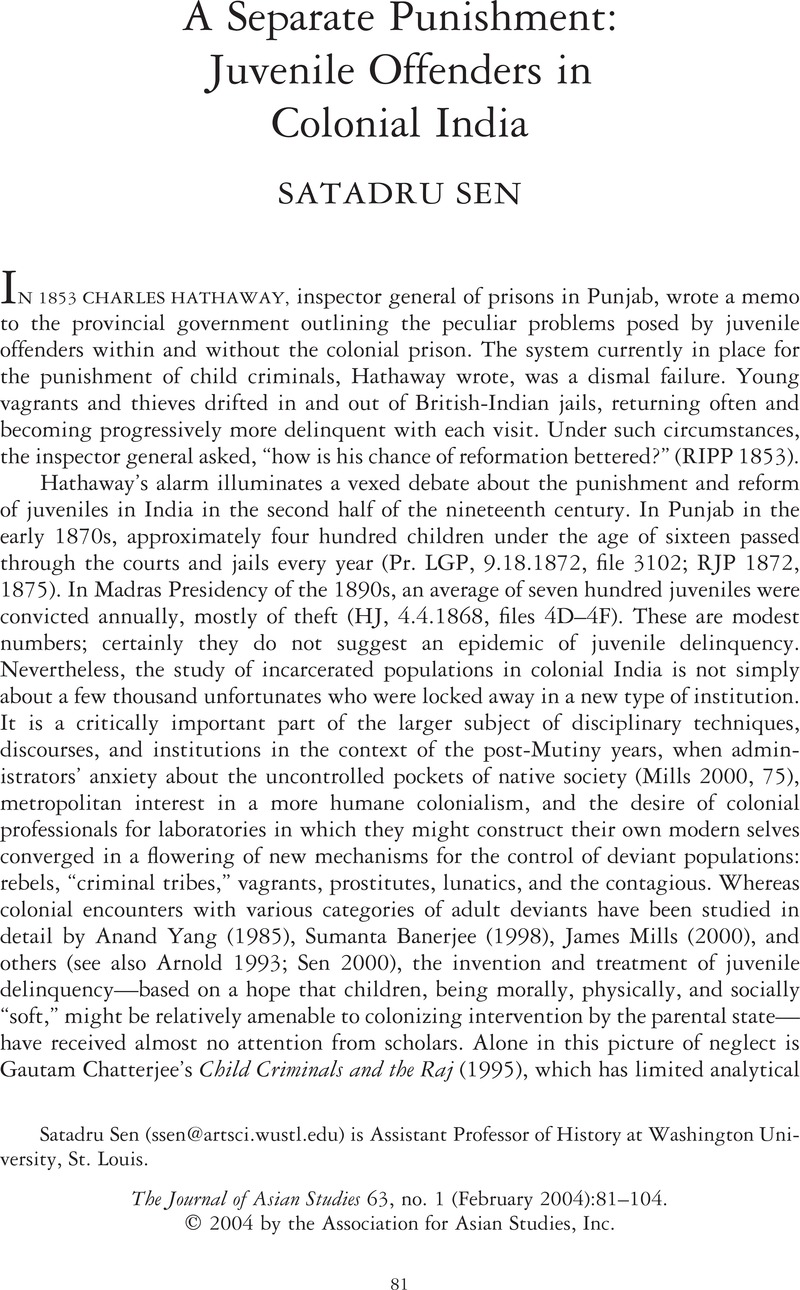Crossref Citations
This article has been cited by the following publications. This list is generated based on data provided by Crossref.
Glover, William J.
2005.
Objects, Models, and Exemplary Works: Educating Sentiment in Colonial India.
The Journal of Asian Studies,
Vol. 64,
Issue. 3,
p.
539.
Sherman, Taylor C.
2009.
Tensions of Colonial Punishment: Perspectives on Recent Developments in the Study of Coercive Networks in Asia, Africa and the Caribbean.
History Compass,
Vol. 7,
Issue. 3,
p.
659.
Pande, Ishita
2013.
‘Listen to the Child’: Law, Sex, and the Child Wife in Indian Historiography.
History Compass,
Vol. 11,
Issue. 9,
p.
687.
McGowan, Abigail
2013.
Convict Carpets: Jails and the Revival of Historic Carpet Design in Colonial India.
The Journal of Asian Studies,
Vol. 72,
Issue. 2,
p.
391.
Linde, Robyn
2014.
The globalization of childhood: The international diffusion of norms and law against the child death penalty.
European Journal of International Relations,
Vol. 20,
Issue. 2,
p.
544.
Bell, Erin
2014.
“A most horrifying maturity in crime”: age, gender and juvenile delinquency in colonial Kenya during the Mau Mau Uprising.
Atlantic Studies,
Vol. 11,
Issue. 4,
p.
473.
2018.
Trier, exclure et policer.
p.
329.
Hynd, Stacey
2018.
Pickpockets, Pilot Boys, and Prostitutes: The Construction of Juvenile Delinquency in the Gold Coast [Colonial Ghana], c. 1929–57.
Journal of West African History,
Vol. 4,
Issue. 2,
p.
47.
Kumar, Shailesh
2019.
Shifting Epistemology of Juvenile Justice in India.
Contexto Internacional,
Vol. 41,
Issue. 1,
p.
113.
MCCLURE, ALASTAIR
2020.
Archaic Sovereignty and Colonial Law: The reintroduction of corporal punishment in colonial India, 1864–1909.
Modern Asian Studies,
Vol. 54,
Issue. 5,
p.
1712.
Soni
2020.
Learning to Labour: “Native” Orphans in Colonial India, 1840s–1920s.
International Review of Social History,
Vol. 65,
Issue. 1,
p.
15.
Ludwig, Manju
2020.
Bodies in pain – Gewalt an sexuell „devianten“ männlichen und Transgender-Körpern im kolonialen Indien.
PERIPHERIE – Politik • Ökonomie • Kultur,
Vol. 40,
Issue. 1 and 2-2020,
p.
125.
2021.
Classify, Exclude, Police.
p.
243.
Kumar, Shailesh
2021.
The Palgrave International Handbook of Youth Imprisonment.
p.
107.
Wilkinson, Tom
2022.
The Undisciplined Youth and a Moral Panic in Independent India, Circa 1947‐1964.
Journal of Historical Sociology,
Vol. 35,
Issue. 4,
p.
507.
Korde, Priyanka
and
Raghavan, Vijay
2023.
Understanding deviance from the perspectives of youth labelled as children in conflict with law in Mumbai, India.
The Howard Journal of Crime and Justice,
Vol. 62,
Issue. 2,
p.
242.



